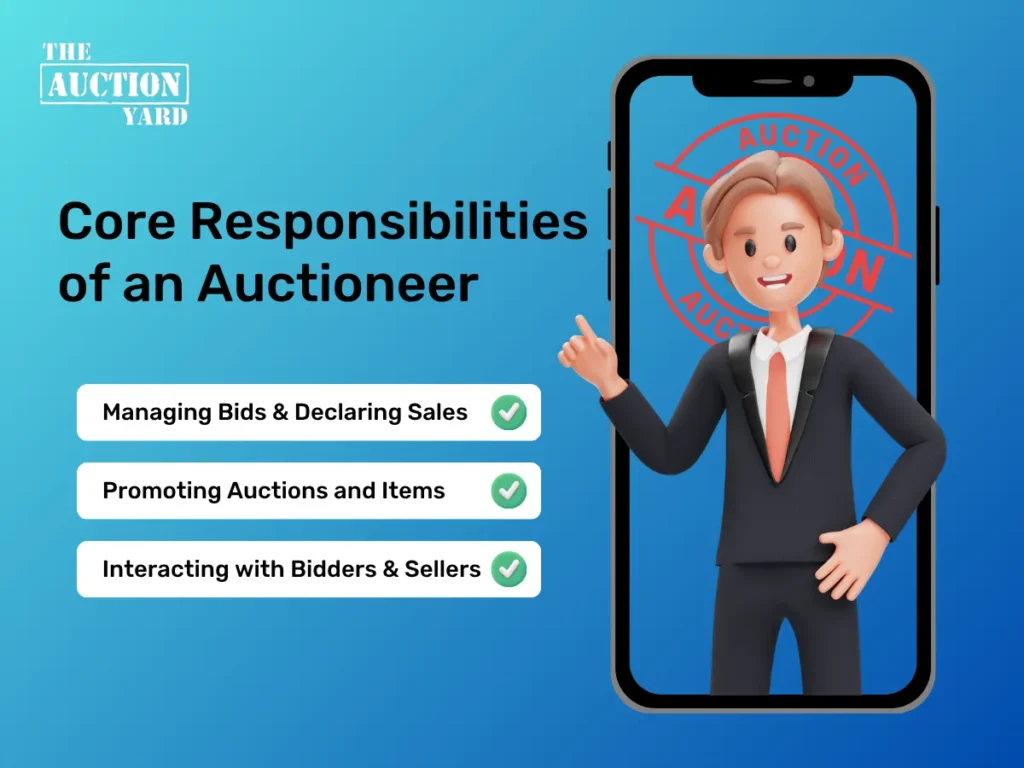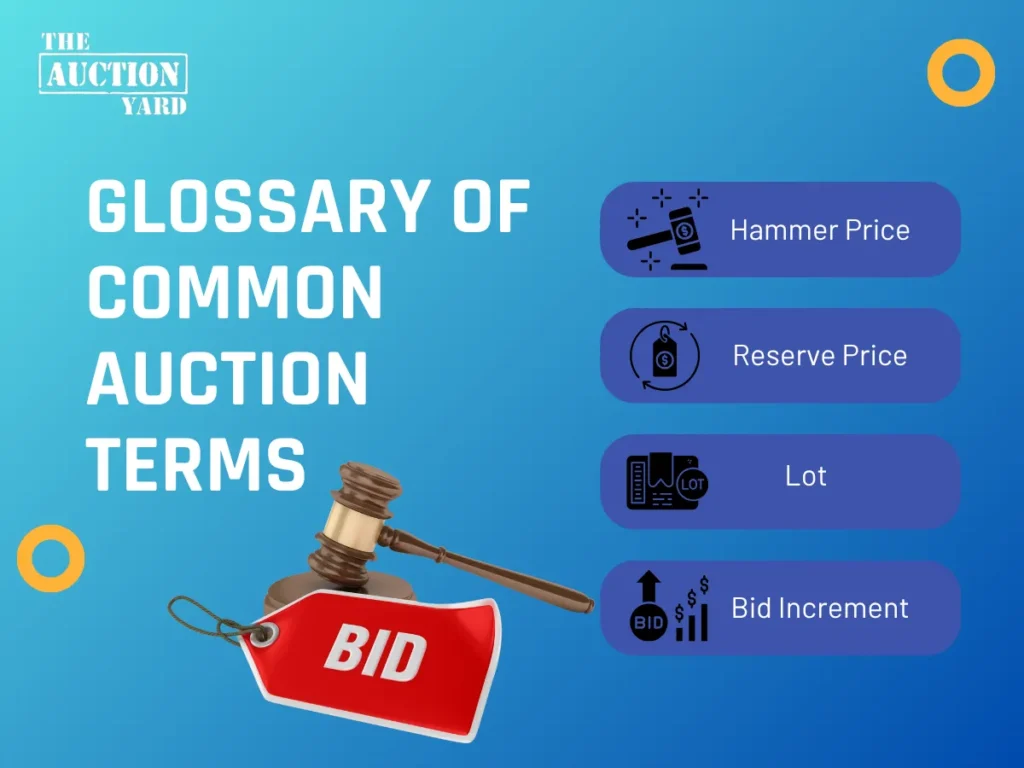What Is an Auctioneer? Responsibilities, Skills, and Qualifications

An auctioneer is a licensed professional who conducts auctions by managing bids, engaging participants, and finalizing sales. This role combines legal oversight, real-time communication, and sales management. Auctioneers operate in diverse sectors, including real estate, automotive, estate liquidation, and charity fundraising.
Besides calling bids, auctioneers manage timing, enforce auction rules, and keep participants informed and engaged. Their presence ensures that the process runs smoothly, legally, and with maximum bidder confidence.
Types of auctioneers vary based on the asset class. For example, a real estate auctioneer manages home and land sales via public bidding, while an auto auctioneer handles volume-driven transactions for vehicles. Other specializations include estate auctioneers, who assist in personal property liquidation, and benefit auctioneers, who support fundraising goals.
In the following sections, we will explore the core responsibilities, live auction techniques, required qualifications, and licensing process. Each part is structured to give you a clear view into the auctioneer's role, skills, and industry dynamics.
Auctioneer Role Simulator
Click bid increments to accept bids. Current bid updates accordingly.
Current Bid: $0
Click the hammer to close the auction and finalize the sale.
Core Responsibilities of an Auctioneer

An auctioneer performs key duties central to auction execution, including managing competitive bids, engaging participants, promoting listings, and finalizing sales. During an auction, the auctioneer manages bidding flow, maintains order, and declares the winning bid using formal phrases or a hammer fall. They also communicate terms, encourage participation, and ensure compliance with relevant laws and auction procedures.
Managing Bids and Declaring Sales
Facilitating live bidding is a core function of the auctioneer, requiring precision and attentiveness. During an auction, the auctioneer accepts offers using recognizable cues such as raised paddles or verbal calls while tracking increments and bidder positions in real time. They control the pace and intensity of the bidding process to keep it competitive and orderly. When no further bids are offered, the auctioneer issues a final call, followed by the hammer fall or an equivalent signal to mark the sale as final and legally binding. This ability to manage competitive bids and declare outcomes ensures fairness and strengthens buyer trust in the auction process.
Promoting Auctions and Items
To ensure strong participation, auctioneers actively promote their events and featured listings in advance. This includes publishing detailed auction catalogs, creating promotional flyers, and posting item previews through online platforms or social media. The auctioneer promotes auctions and listings to attract buyers by emphasizing key attributes such as rarity, item condition, estimated value, or starting bid range. Public previews or scheduled inspection times allow buyers to examine items before bidding. Well-targeted promotion increases visibility and raises the likelihood of active, competitive bidding, improving final sale results.
Interacting with Bidders and Sellers
Effective interaction with bidders and sellers is essential for a smooth and transparent auction. The auctioneer works with sellers beforehand to review item details, confirm terms of sale, and establish reserve prices if applicable. For bidders, the auctioneer provides clear guidance on registration, bidding steps, and payment procedures. During the event, the auctioneer answers questions, clarifies conditions, and restates important terms, maintaining transparency and professionalism. Such a gesture helps build trust and keeps the auction environment fair and controlled, benefiting the participants.
Core Responsibilities of an Auctioneer
0 of 5 responsibilities completed
-
Accept and track bids in real time, control bidding pace, and declare winning bids.
-
Publish catalogs, create flyers, and use social media to attract bidders.
-
Provide clear guidance, answer questions, and ensure transparency.
-
Ensure compliance with regulations and maintain order during auctions.
-
Use formal calls and hammer fall to close sales legally and clearly.
Live Auctioneering Techniques and Execution

An auctioneer employs live techniques like rhythmic bid calling, controlled bid increments, and crowd reading to conduct auctions with speed, control, and engagement. The auctioneer uses vocal cadence and pacing to maintain momentum, ensures bid rules are followed, and adjusts delivery based on bidder behavior. These live execution skills help create urgency, keep participants focused, and support orderly bidding from start to finish. Each element, from the chant to the hammer fall, boosts auction efficiency and bidder confidence.
Conducting the Auction Chant
The auction chant is a vocal pattern auctioneers use to keep bidding active and focused. It combines numbers with filler words in a steady rhythm that encourages quick decision-making.
A standard chant may sound like “I have five hundred, now five fifty, will you go six?” or “One thousand, one thousand one, looking for eleven hundred.” The speed, tone, and complexity of the chant often vary by auction type. For example, benefit auctions may use a more conversational chant to engage a mixed audience, while auto auctions tend to favor faster, abbreviated chants due to high volume. A clear and controlled chant helps bidders stay informed and supports a consistent auction flow.
Handling Bid Increments and Disputes
Auctioneers control the flow of bidding by setting and enforcing bid increments, which are the minimum amounts by which each new bid must exceed the previous one. These increments are often determined based on the item’s estimated value or auction rules. For example, a vehicle might have a $100 bid increment, while a collectible item could increase by $10 per bid. The auctioneer announces and monitors these steps throughout the event.
When disputes arise, such as two bidders claiming the same offer or a missed bid, the auctioneer must pause the auction, resolve the issue promptly, and make a clear ruling. Maintaining authority in these situations helps preserve fairness and keeps the auction on track.
Closing with the Hammer Fall
The hammer fall is the final act that signals the completion of a sale at auction. Once bidding slows and no further offers are made, the auctioneer gives a final verbal call such as “Going once, going twice, sold” and strikes the hammer to indicate the sale is closed. This action marks a legally binding agreement between the highest bidder and the seller. The use of the hammer provides a clear, visible cue that the item is no longer open to bids.
In some auctions, hand gestures or verbal confirmations may substitute for the physical hammer. The purpose remains the same and confirms the winning bid while finalizing the transaction with authority.
Skills and Qualifications Needed

Success in auctioneering relies on strong communication, presence, and technical awareness. Effective auctioneers demonstrate vocal strength, confidence, adaptability, and quick decision-making. Clear diction and pacing maintain order during fast-paced bidding. They must also read the room, adjust strategies on the fly, and manage legal responsibilities. These skills build trust, ensure fair transactions, and support consistent performance across auction types.
Personal Traits of Successful Auctioneers
The personality of an auctioneer plays a crucial role in shaping the flow and success of an auction. Confidence is essential, as it commands attention and establishes authority from the beginning. When combined with clear and articulate speech, it ensures that bidders can follow the proceedings without confusion, even during rapid bidding.
Composure is equally important, allowing the auctioneer to remain calm and in control when handling disputes or unexpected situations. These qualities work together to create a professional and engaging auction atmosphere. Ethical conduct further strengthens this environment by promoting fairness and transparency. When these personal traits are aligned, they build trust and motivate buyers and sellers to participate with confidence.
Voice Control and Communication
Strong voice control and clear communication are fundamental to an auctioneer’s effectiveness. A well-projected voice with controlled volume, steady rhythm, and distinct pronunciation of bid amounts ensures that all participants can follow the auction without confusion. This clarity not only prevents missed bids but also maintains a consistent and engaging pace.
To achieve this, auctioneers must be able to adjust their tone and pitch according to the size of the venue and the energy of the crowd. Developing such vocal versatility often requires formal training or vocal coaching, which typically includes breathing techniques, diction practice, and pitch modulation exercises. These refined communication skills reinforce the auctioneer’s authority and help sustain bidder focus from start to finish.
Crowd Reading and Confidence
Reading the crowd is a key skill that allows auctioneers to adjust their delivery and maintain control throughout the event. By observing body language, energy shifts, and bidder engagement, the auctioneer can decide when to slow down, pause, or raise their intensity. This awareness helps them respond in real time, whether to encourage hesitant bidders or to calm a tense atmosphere. Confidence plays a central role in these adjustments, allowing the auctioneer to act decisively and keep the auction moving smoothly. For example, a confident pause before a final call can increase anticipation and prompt one last bid, improving the final outcome.
Skills and Qualifications Self-Assessment
How to Become a Licensed Auctioneer?

Becoming a licensed auctioneer typically requires formal training, hands-on experience, and passing a state-approved exam. While requirements vary by region, most begin with an apprenticeship or enrollment in a certified auction school. This training covers bid calling, legal regulations, and ethical standards. Candidates often must pass an exam on auction law, sales techniques, and professional conduct. Some states also require continuing education or periodic renewals. Prospective auctioneers should consult their local licensing authority for specific guidelines.
Apprenticeship and On-the-Job Training
An apprenticeship provides aspiring auctioneers with direct, hands-on experience under the supervision of a licensed professional. In Texas, apprentices must hold a license for at least two years, participate in ten live auctions, and complete 80 hours of instruction at a TDLR-approved auction school. During this period, trainees assist with auction setup, bid tracking, item presentation, and sometimes call bids under guidance. The goal is to build practical skills while learning the flow and responsibilities of a live auction environment.
In states like North Carolina and Indiana, a specific number of auctioneer-supervised hours or events is mandated, making this phase not only educational but also legally necessary. Through real-world involvement, apprentices gain confidence, understand auction flow, and build a working knowledge of operations and regulations.
Auctioneer Schools and Certification Courses
Formal training through an auctioneer school provides structured education in auction techniques, legal requirements, and business practices. These programs typically cover bid calling, voice control, ethics, marketing, and contract law. Reputable institutions such as America’s Auction Academy and Missouri Auction School prepare students for real-world auctions and state licensing processes.
States such as Indiana and Georgia require graduation from an approved auction school before taking a licensing exam. For instance, Indiana mandates 80 hours of instruction followed by a written and oral exam. Georgia uses the PSI-administered Auctioneer License Examination, which includes state laws and contract handling. Many auctioneers also pursue designations like Auction Marketing Management (AMM) or Graduate Personal Property Appraiser (GPPA) to enhance their credentials.
Course durations range from a few days to several weeks, depending on program depth, and costs vary by location. Completing certified training builds essential skills and demonstrates professionalism to clients and regulatory boards.
Licensing Exams and Credentialing
To become a licensed auctioneer, candidates must pass a state-recognized licensing exam that assesses their understanding of auction law, ethics, bid calling, and business procedures. Exam content often includes topics such as contract terms, disclosure requirements, and proper handling of funds.
Some states require fingerprinting or background checks as part of the credentialing process. Licensing boards, such as the Alabama State Board of Auctioneers or the Texas Department of Licensing and Regulation, oversee the examination and certification process. Passing this exam is a critical step toward becoming a legally recognized auctioneer and operating within regulated markets.
How to Become a Licensed Auctioneer
Specializations in Auctioneering

Auctioneers often specialize by asset type, applying specific methods suited to different markets. Common specializations include estate, real estate, auto, and benefit auctions. Each requires a tailored approach, from legal coordination to audience engagement, depending on the items and clients involved.
Estate Auctioneers
An estate auctioneer handles the sale of personal or inherited property through organized public bidding. These auctions often occur during family transitions, downsizing, or probate settlements, featuring items like furniture, antiques, artwork, and collectibles. Estate auctioneers work with family representatives or estate planners to catalog assets and schedule viewings. In probate cases, they may coordinate with attorneys to ensure legal compliance. For example, when settling a deceased individual’s estate, the auctioneer helps liquidate assets, converting them into cash with clear documentation. This role blends sensitivity and professionalism to support families during key life changes.
Real Estate Auctioneers
A real estate auctioneer manages property sales through auctions using a specialized, licensed approach. These professionals oversee the entire process, from marketing and bidder screening to the live auction and final sale. They often handle residential homes, commercial buildings, land parcels, and foreclosures. To ensure legal accuracy, they must understand disclosure laws, title transfers, and zoning rules. Auctions may be held on-site, online, or in venues like courthouses, depending on state regulations. By combining legal knowledge with market insight, they ensure a transparent and efficient experience for both sellers and buyers.
Auto Auctioneers
Vehicle auctions require a fast pace, precise execution, and close attention to detail, all managed by a skilled auto auctioneer. These professionals are responsible for conducting the sale of a wide range of vehicles, including cars, trucks, motorcycles, and commercial fleets, in both public and dealer-only auctions. Vehicles may be used, new, repossessed, or salvage-titled, requiring proper inspection and disclosure. The auctioneer ensures bidders receive clear information on condition, mileage, and title status. To maintain momentum, they communicate efficiently and move swiftly through inventory, often selling dozens of vehicles per hour. Their role demands a balance of speed, accuracy, and effective communication.
Benefit Auctioneers
Fundraising auctions rely on the unique skills of benefit auctioneers to create an engaging and profitable event. These professionals work with nonprofits, schools, and charitable organizations to host auctions that inspire giving and maximize contributions. Their responsibilities include presenting items, interacting with donors, and driving momentum through effective bid calling and audience engagement. Events often feature live auctions, pledge appeals, or themed galas, where the auctioneer helps explain the cause, energize the crowd, and encourage participation. By combining sales expertise with a sense of mission, benefit auctioneers play a critical role in helping organizations reach their fundraising goals.
Select an Auctioneer Specialization
Estate Auctioneer: Handles sale of personal/inherited property, working with families and estate planners. Manages furniture, antiques, artwork, ensuring sensitive and professional liquidation.
Glossary of Common Auction Terms

Hammer Price
The hammer price refers to the final accepted bid at the moment the auctioneer signals the sale, typically with a verbal confirmation or a hammer fall. It represents the amount the winning bidder agrees to pay, excluding any additional fees such as buyer’s premiums or taxes. For example, if bidding ends at $2,000 and the auctioneer says “Sold,” the hammer price is $2,000. This value becomes the legal basis for the transaction between buyer and seller.
Reserve Price
The reserve price is the minimum amount a seller is willing to accept for an item at auction. It is usually set in advance and kept confidential from bidders. If bidding does not reach this amount, the item may be withdrawn from the sale. For example, if a car has a reserve price of $5,000 and the highest bid is $4,800, the auctioneer will not declare it sold. Reserve prices protect sellers from underselling valuable items.
Lot
A lot refers to a single item or a grouped set of items offered for sale during an auction. Each lot is assigned a number and listed in the auction catalog for identification. For example, Lot 15 might include a set of vintage coins or a single piece of furniture. Bidders refer to these numbers when placing bids, and auctioneers use them to announce and track each sale accurately.
Bid Increment
A bid increment is the minimum amount by which a new bid must exceed the previous bid. It helps structure the pace of bidding and ensures consistent progress during the auction. The auctioneer sets this amount based on the value of the item or auction rules. For example, for items under $500, the bid increment might be $10, while higher-value items may increase in steps of $100 or more. Stating and enforcing bid increments keeps bidding fair and organized.
FAQs About Auctioneers
An auctioneer conducts live auctions by calling bids, managing the flow of offers, and finalizing sales with a clear declaration. Their role includes presenting items, encouraging participation, monitoring bidding activity, and confirming winning bids. They also ensure the auction follows legal and procedural standards. By combining communication skills with quick decision-making, auctioneers help sellers achieve fair prices and keep the auction process organized and transparent.
A good auctioneer demonstrates vocal clarity, confidence, adaptability, and quick thinking. These skills help maintain control during fast-paced bidding and ensure participants stay engaged and informed. Strong communication allows the auctioneer to explain terms clearly, while confidence supports authority and presence. Adaptability enables them to adjust strategies in response to the crowd, and quick thinking helps manage disputes or unexpected events in real time.
Auctioneers earn a monthly income of $4,008, as per ZipRecruiter. Their incomes is subject to commissions, flat fees, and event-based payments, depending on the types and frequency of auctions they conduct. High-demand sectors like real estate and auto auctions often offer higher compensation. Income also depends on location, specialization, and licensing requirements.
No, auctioneer licensing is not mandatory in every U.S. state. Some states, such as Texas and Alabama, require auctioneers to hold a license, while others do not enforce licensing laws. States with requirements may mandate formal education, apprenticeships, or passing a licensing exam. It is important to check with the local licensing authority for specific rules.


